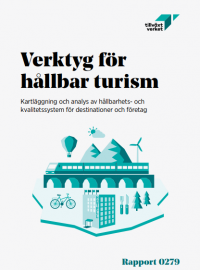The Swedish Agency for Economic and Regional Growth identifies the GSTC Criteria as the key Tool for Sustainable Tourism

In Sweden, the Swedish Agency for Economic and Regional Growth is responsible for promoting the competitiveness of the tourism industry through knowledge development, collaboration and financing. As part of the Agency’s work with knowledge development, Ramboll Management Consulting was given the task of contributing to knowledge creation concerning how different methods and models for work on quality and sustainability can be used at both destination and company level. In this survey, we see that:
There are many tools available for Swedish tourism companies and destinations. These tools include certifications, labels, monitoring systems and standards. The mapping exercise includes national tools in Sweden and international tools that are available in Sweden. A total of 40 tools have been identified, most of them aimed at companies, but there are also tools available for destinations. The most common approach is to focus on the environmental aspect, but social and economic sustainability have become more common over time, and it appears that the tools are assuming a holistic perspective on sustainability. Many certifications at destination level are based on the standard established by the Global Sustainable Tourism Councils (GSTC), whose framework links into the global goals of Agenda 2030. Of Ramboll’s identified tools, a good one third are based on GSTC-D for destinations.
Sustainability tools can generate different kinds of added value for a destination. An analysis of the work of Swedish destinations on certification shows that the use of sustainability tools can generate different kinds of added value. It can enable benchmarking and the sharing of experience between destinations, while monitoring individual indicators can enable a destination to continuously measure its climate impact. Several of the certifications used are based on the criteria established by GSTC, which makes comparison possible. A certification in itself does not necessarily result in increased sustainability, but it can create transparency and structure around how sustainability work can be undertaken. Strategic sustainability work at destination level often requires companies to be involved and contribute. It is important to be able to highlight the benefits for companies of working with these issues and thereby creating more sustainable destinations.
By adding ambition at the right level, certifications can help companies to work more strategically with sustainability. Certifications and labels can help companies in the tourism industry to work strategically with sustainability. It is important to adjust the level of ambition to the size and capacity of the company, so that the work does not become overwhelming. In this way, the work can support the development of companies, rather than imposing an administrative burden. This appears to be something that the tourism industry has been able to do, as companies are working actively to a greater extent than other small and medium-sized enterprises on environmental issues, as well as social and ethical issues, while at the same time recognising the commercial benefit of it.
Read the full report: Tools for Sustainable Tourism (Verktyg för hållbar turism) by the Swedish Agency for Economic and Regional Growth (May 2019)




